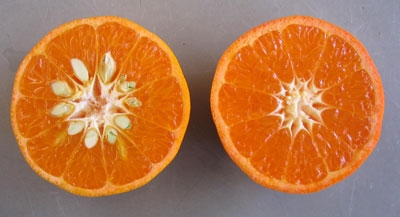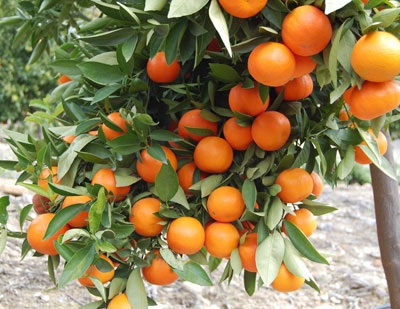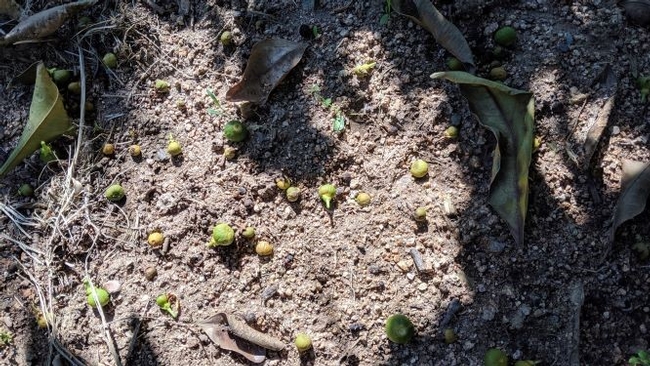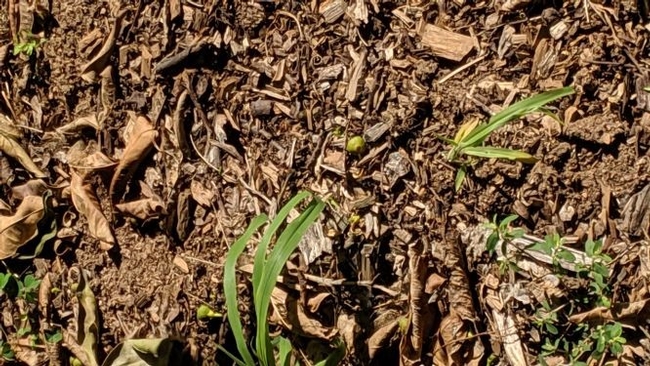
Posts Tagged: mandarin
Observations on Mandarin Mulching Research
Two years ago, UCCE Placer/Nevada embarked on a study to evaluate pruning and mulching in five local mandarin orchards. In a blog posted in June 2017, I discussed the beginnings of the study, the specific treatments and what the study was hoping to accomplish in the coming years. As the study enters the third year and data analysis begins, there are some observations that we should share.
The environment in our orchards is changing. We are experiencing unpredictable temperature swings and extreme periods of rainfall. Soil moisture levels this past winter and spring reached saturation levels for a prolonged period.
Roots need both water and oxygen. In saturated soils, oxygen in the soil pore spaces is displaced by water. This year, tree stress increased as the roots struggled to breathe. When root cells can't get oxygen, they die. Without them, the rest of the tree starts to die too. Many of us suffered tree loss due to the suffocation of root systems.
As orchards and fields began to dry, temperatures began to swing from high to low in unpredictable patterns. Stress was further introduced into the system. In the past few weeks, recorded temperatures in the five orchards have gone from lows in the 40's to recorded highs of 105 in the first few weeks of June. Citrus has a tendency to drop fruit that the tree cannot support and increased tree stress can increase fruit drop.
Field observations over the past few weeks show that drop is occurring at a much higher rate and volume in treatments that haven't been mulched. The picture on the left is from underneath the canopy of a tree without mulch (Control) and to the right is a mulched tree. These two trees are in the same orchard, approximately 18 feet apart.
Soil moisture levels are being monitored under both of these trees. Moisture levels under the mulched tree are consistent with what one would expect. The soil profile is able to retain moisture with minimal depletion at a 6-12” depth. Most moisture depletion is occurring in the top 6” of soil and is minimal compared to the Control. Moisture levels in the Control deplete at a more rapid rate throughout the soil to a depth of 12”. Once again, tree stress is on the rise. The soil moisture in the Control profile becomes much harder to replenish, resulting in longer irrigation cycles.
Soil temperature at a depth of 9” is also being monitored. Data from the Control show rather significant increases and decreases in temperatures in short periods of time. Data from the mulched tree reflect more temperature stability with the highs lower than those in the Control soil. Again, it seems that the Control may be under more stress due to the rapid temperature swings that the root mass is encountering.
It would certainly seem that a cursory examination of the data with field observations shows that mulching is a beneficial production practice in an orchard. However, there are some considerations to be had before one just charges ahead with this practice.
First, as we learned, timing is everything. Mulch should only be applied when the moisture in the soil profile is at capacity. Experience has taught us that applying the mulch when soil moisture is low results in playing catch up. I have observed orchards that were never able to replenish the full soil moisture content during the irrigation season.
Second, monitoring soil moisture is important. Mulching will change your irrigation timing and frequency. In our study, the period between irrigation cycles in mulched orchards has increased. Maturation appeared to be slowed in orchards that chose to stay with their old programs and not effectively monitor the soil moisture. Mulch reduces moisture loss from the soil, so if irrigation was not adjusted, the soil under the mulch stayed too wet. While less dramatic than the saturated soil situation this spring, stress was induced by the tree roots struggling to obtain oxygen and maturation slowed.
Certainly, mulching requires a little more effort on the grower's part. But is the not the reduction or control of the stress induced in the growing system beneficial to the entire orchard system? As a grower, I know that adding a little bit of stress into my trees at the right time and conditions is good for the fruit. Adding that stress at a time when it will not damage the tree or cause crop loss is key. Mulching certainly seems to mitigate stress in the growing system when stress is detrimental to the crop and system. Further data analysis will also provide us with more insight into the benefits that the mulch provides to the soil biology and composition. We will share those insights as they become available.
Scientific ingenuity produces a fantastic fruit
UC scientists took a page from nature when they developed the Tango mandarin. Tango is the result of a mutation induced by irradiating budwood of W. Murcott mandarin. The process mimics nature’s manner of improving fruit. Radiation from the sun or natural errors during cell division can cause a single branch or fruit to mutate and develop unique characteristics, which scientists call a “sport.” People have been reproducing favorable sports for generations. In fact, all navel oranges are sports – natural mutations of oranges with seeds or other navel oranges.
W. Murcott mandarins, originally from Morocco, are favored for their deep orange color, easy-peel rind and tangy-sweet flavor. However, when planted within five miles of other seed-bearing citrus – such as Clementine mandarins, lemons or grapefruit – they can be cross-pollinated by bees and become seedy. The Tango maintains the best W. Murcott traits, but because it produces very little viable pollen, it is virtually seedless wherever it is grown.
“This is the most promising mandarin the university has ever produced,” said UC Riverside genetics professor Mikeal Roose.
The Tango mandarin was patented, and registered trees were established by the UC Citrus Clonal Protection Program. Distribution of budwood to citrus nurseries began in June 2006 and was limited exclusively to California growers for one year. Tango was introduced into Florida in 2007 and the trees were available internationally under exclusive licenses since 2009. Tango trees are available to home gardeners through retail nurseries.
The Tango was made possible by a UC and citrus industry partnership going back nearly 15 years. Roose and staff research associate Tim Williams began field testing the fruit in 2001. The research and evaluation program was supported by the Citrus Research Board.
“What’s exciting is the parent variety of the Tango is a good piece of fruit,” said Ted Batkin, director of the Citrus Research Board. “It is without a doubt the most widely planted variety that we have released in the past 25 years.”
California is the nation's leader in producing fresh citrus fruit, and many of the fruit is exported overseas, providing nutritious, low-calorie food to consumers worldwide.

W. Murcott, left, and Tango, right.
Mandarin Festival Local Food Dot Survey Results
The Mountain Mandarin Festival wrapped up on Sunday, amidst sun and happy shoppers. Though it rained like heck on Saturday, the Festival nevertheless saw a tremendous turnout. Overall, the Festival was a huge success.
At the UCCE booth, we held tastings of PlacerGrown fruit, and conducted a simple Local Food Dot Survey. The shoppers leapt at the chance to taste Fuyu persimmons, Fuji apples, Yali and Okusankicki Pears.
There were over 300 responses for The Dot Survey, which yielded insightful results. Full results can be seen on the table below, but here are some of the more thought-provoking highlights:
- 52.9% of respondents answered that they purchased locally grown fruits and veggies weekly.
- 49.2% of respondents answered that they purchased these fruits and veggies at a farmers’ market.
- 47.7% cited convenience as the main factor keeping them from purchasing more locally grown fruits and veggies
- 47.7% defined “local” as “From my county and adjacent counties.”
One main point to keep in mind is that the shoppers at the Mountain Mandarin Festival likely do not represent shoppers in general. Consider that this festival is billed around locally grown mandarins, add in the non-stop rain on Saturday, and we can surmise that these shoppers are more likely than most to purchase locally grown products. This is evidenced by the fact that 52.9% said they purchased locally grown fruits and veggies weekly, and 49.2% responded that they purchased these fruits and veggies at a farmers’ market.
That said, 47.7% still responded that convenience (or lack thereof) was the major factor keeping them from purchasing more locally grown fruits and vegetables. Based on these results, ease-of-access is paramount to growing the local food movement. Armed with this data, we will need to consider how to make local food, and the markets that offer it, more readily accessible and convenient.
One of the more interesting insights cannot be extrapolated from the data on the table. While speaking with people over the weekend, we noticed that some shoppers believe that any food purchased at a local grocery store (such as Briar Patch Co-op) is “local”. For instance, one respondent told me that she only purchased locally produced fruits and veggies. I then asked her if she ate bananas. She replied that she did. I then pointed out that bananas are not grown locally, but she countered that they are from Briar Patch. This was one example of confusion between “locally grown fruits and veggies”, and a “local grocery store.” I do not know how prevalent this confusion is in our society, but it is something to consider. The other side of the coin would be that it does not matter, and that as long as people are shopping at a store like Briar Patch, they are inevitably going to run into local produce, so we should not discourage those types of shopping habits.
All in all, the Local Food Dot Survey gave insight into what we can do to make sure that, in the future, more people are making weekly purchases of locally grown fruits and vegetables.
Dot Survey Results
Tango to be a big hit
A new, virtually seed-free mandarin will for the first time be sold in California grocery stores, but consumers may not even notice, according to an AP story by Jeff Nachtigal published late last week. Google News reports that the article made its way into about 200 news outlets.
The story was also written up by reporter Mark Muckenfuss of the Riverside Press-Enterprise in mid-January.
UC Riverside began releasing budwood for Tango mandarins in 2006; more than a million trees are now growing in California. Their first commercial crop is being harvested this month.
Tango is the result of a mutation induced by irradiating budwood of W. Murcott mandarin in UC Riverside genetics professor Mikeal Roose's lab. It has all the good qualities of W. Murcott, but doesn't produce seeds even if bees visit the blossoms covered in pollen from other citrus trees.
Roose told Nachtigal the new mandarin is "like a new car with all the details of the previous year's model, but one that gets 10 miles more to the gallon."
"It's probably the best piece of fruit that's come along for years for citrus growers," Roose was quoted.
Roose said Tango will most likely be marketed as Cuties and Delites. Some may be sold under the Tango name at grocery stores and farmers markets.

W. Murcott mandarin (left) and Tango (right).
Placer welcomes mandarin lovers
Having skirted damage from last week's freeze threat, Placer County is now ready to welcome visitors from the valley to buy foothill mandarins, said an article in the Sacramento Bee.
Mandarins are a signature crop in Placer County, where the climate and soil produce particularly flavorful fruit, according to a UC Cooperative Extension mandarin information page. Mandarins are more cold tolerant than all other citrus except kumquats.
The Mountain Mandarin Association's website says the first mandarin orange trees were planted in Placer County in the 1880s. According to the agricultural commissioner's crop report, Placer County citrus fruit was valued at $1,223,545 in 2009.
The association website offers maps to the county's 30 producers, an attraction guide, nutrition information and recipes.

Mandarins make lovely holiday gifts.


